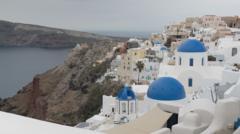In the picturesque landscape of Santorini, a world-renowned tourist destination, danger lurks beneath its serene surface. A significant eruption approximately 3,600 years ago sculpted the island's iconic features, but scientists now focus on averting a potential catastrophe as they investigate the risks posed by its volcanic underbelly. Recent seismic activity that shook Santorini serves as a stark reminder that tectonic forces still influence the region.
Aboard the British research vessel RRS Discovery,
Prof. Isobel Yeo from the National Oceanography Centre leads a team probing the depths of the sea beneath Santorini. "Underwater volcanoes can unleash catastrophic events," she states, underscoring the need for vigilance. The team aims to assess the seismic activities that might herald an eruption, noting that the last significant volcanic activity on the island occurred in 1950. In recent years, there's been magma activity that swelled the land, hinting at unrest beneath the surface.
Despite the enchanting allure of Santorini’s idyllic villages, restaurants, and wineries, the overarching threat from two tectonic plates applying pressure beneath the surface cannot be dismissed. Hearing accounts of prior volcanic events from residents, such as geologist Prof. Paraskevi Nomikou, who hails from the island, highlights the importance of their findings. The researchers are gathering data for Greek emergency services, which could define safe zones during future volcanic activity.
Their expedition will delve into the underwater volcano Kolombo, located nearby, while aiming to pinpoint areas of potential risk. Prof. Nomikou asserts, "It’s crucial to communicate these findings to the people, guiding them on safety amidst volcanic volatility."
Equipped with underwater robots and sophisticated technology, the scientists gather samples and data, striving to chart out the hydrothermal systems that play a role in volcanic eruptions. The mission concerns not just geology but also ensuring that the residents and tourists of Santorini can confidently navigate their coexistence with nature's unpredictability.
The island's charm continues to draw tourists despite the underlying risks, though some visitors express trepidation. Local photographer Eva Rendl admits that her business has taken a hit due to recent cancellations, as potential clients hesitate to visit the renowned locale. Meanwhile, some newlyweds remain undeterred, actively seeking to capture their special moments against the backdrop of the island's volcanic terrain.
Local residents, especially those reliant on tourism, keep a watchful eye on scientific developments, hoping that better forecasting will help mitigate fears of future eruptions. The ongoing research stands testament to the delicate balance between nature's wonder and the unpredictability it brings, as Santorini remains an ever-popular destination, drawing couples and travelers with dreams of romance mixed with a hint of natural adventure.
Aboard the British research vessel RRS Discovery,
Prof. Isobel Yeo from the National Oceanography Centre leads a team probing the depths of the sea beneath Santorini. "Underwater volcanoes can unleash catastrophic events," she states, underscoring the need for vigilance. The team aims to assess the seismic activities that might herald an eruption, noting that the last significant volcanic activity on the island occurred in 1950. In recent years, there's been magma activity that swelled the land, hinting at unrest beneath the surface.
Despite the enchanting allure of Santorini’s idyllic villages, restaurants, and wineries, the overarching threat from two tectonic plates applying pressure beneath the surface cannot be dismissed. Hearing accounts of prior volcanic events from residents, such as geologist Prof. Paraskevi Nomikou, who hails from the island, highlights the importance of their findings. The researchers are gathering data for Greek emergency services, which could define safe zones during future volcanic activity.
Their expedition will delve into the underwater volcano Kolombo, located nearby, while aiming to pinpoint areas of potential risk. Prof. Nomikou asserts, "It’s crucial to communicate these findings to the people, guiding them on safety amidst volcanic volatility."
Equipped with underwater robots and sophisticated technology, the scientists gather samples and data, striving to chart out the hydrothermal systems that play a role in volcanic eruptions. The mission concerns not just geology but also ensuring that the residents and tourists of Santorini can confidently navigate their coexistence with nature's unpredictability.
The island's charm continues to draw tourists despite the underlying risks, though some visitors express trepidation. Local photographer Eva Rendl admits that her business has taken a hit due to recent cancellations, as potential clients hesitate to visit the renowned locale. Meanwhile, some newlyweds remain undeterred, actively seeking to capture their special moments against the backdrop of the island's volcanic terrain.
Local residents, especially those reliant on tourism, keep a watchful eye on scientific developments, hoping that better forecasting will help mitigate fears of future eruptions. The ongoing research stands testament to the delicate balance between nature's wonder and the unpredictability it brings, as Santorini remains an ever-popular destination, drawing couples and travelers with dreams of romance mixed with a hint of natural adventure.




















